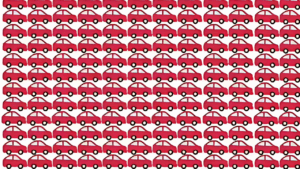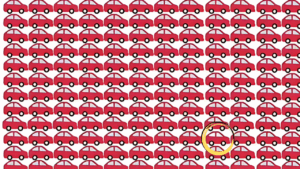Optical illusions captivate us by blending art, psychology, and neuroscience into brain-teasing challenges that test our perception. The latest viral sensation, “Spot the Odd Car in Under 4 Seconds,” has swept across social media, daring even the sharpest minds to identify a single car that stands out in a grid of seemingly identical vehicles. With just four seconds to pinpoint the anomaly, this puzzle pushes your observation skills, mental agility, and focus to the limit. In this 1500-word exploration, we’ll uncover the mechanics of this optical illusion, explain why it’s so challenging, highlight its cognitive benefits, share strategies to conquer it, compare it to other popular illusions, and delve into its widespread appeal, complete with a table of similar challenges.

The Odd Car Challenge: A Visual Puzzle Unveiled
The “Spot the Odd Car in Under 4 Seconds” optical illusion presents a 5×6 grid of 30 cars, each appearing nearly identical at first glance. Popularized by sources like The Times of India and Jagran Josh, the cars typically feature a uniform design—often pink or red, with similar shapes, windows, and wheels. However, one car hides a subtle difference, such as a missing side mirror, a different wheel pattern, or a slight color variation. The challenge is to locate this “odd one out” within a tight four-second window, a task that tests both visual acuity and cognitive speed.
The puzzle’s deceptive simplicity is its greatest strength. The uniformity of the cars exploits the brain’s tendency to group similar objects, a process known as perceptual grouping, making the anomaly nearly invisible. The four-second time limit adds intense pressure, forcing you to balance speed and precision. Whether you’re a puzzle enthusiast or a casual observer, the challenge is both thrilling and frustrating, as the odd car often hides in plain sight, blending seamlessly with its neighbors.
The Science of Optical Illusions
Optical illusions like this one work by exploiting the brain’s visual processing shortcuts. Our visual system is designed to interpret complex scenes quickly, often prioritizing patterns over individual details. When you view the grid of cars, your brain groups them as identical to reduce cognitive load, a phenomenon rooted in Gestalt psychology. This makes spotting the odd car difficult, as the brain overlooks subtle differences in favor of a cohesive whole.
The challenge engages multiple brain regions:
-
Visual Cortex: Processes shapes, colors, and patterns, decoding the raw visual data from the grid.
-
Prefrontal Cortex: Manages attention and decision-making, helping you focus under time constraints.
-
Parietal Cortex: Aids in spatial navigation, allowing you to scan the grid systematically.
The four-second deadline intensifies the challenge by triggering a mild stress response, which can impair focus and increase errors. This interplay between perception and cognition is what makes the odd car illusion both a mental workout and a source of exhilaration.
Why Is It So Hard to Spot the Odd Car?
The difficulty of this illusion lies in its design. The uniform color and repetitive car shapes create visual overload, overwhelming the brain’s ability to detect anomalies. The tight time limit exacerbates this, as four seconds is barely enough to scan all 30 cars. Additionally, the subtle nature of the difference—perhaps a slightly darker shade or a missing detail—requires hyper-focused attention, which is challenging under pressure.
This illusion also taps into the brain’s “change blindness,” where small changes go unnoticed when surrounded by similar stimuli. For example, if the odd car has a different wheel spoke count, your brain might skip over it because it’s processing the grid as a whole. The combination of visual similarity, time pressure, and cognitive bias makes this puzzle a formidable test of perception.
Cognitive Benefits of Optical Illusions
Engaging with optical illusions like the odd car challenge offers significant cognitive benefits, backed by research in cognitive psychology:
-
Enhanced Observation Skills: Regularly spotting differences sharpens your ability to notice subtle details, a skill valuable in tasks like proofreading or quality assurance.
-
Improved Concentration: The need to focus under time pressure trains your brain to block distractions, enhancing sustained attention.
-
Boosted Problem-Solving: Illusions encourage creative thinking, as you must look beyond obvious patterns to find the anomaly.
-
Cognitive Flexibility: Switching perspectives to identify differences hones mental agility, helping you adapt to new challenges.
-
Stress Relief: Solving puzzles can be meditative, offering a mental break from daily stressors and promoting relaxation.
For those who solve the challenge in four seconds, it’s a sign of exceptional visual processing and high IQ, as the task demands rapid pattern recognition and decision-making. Even if you don’t succeed, the process of trying strengthens your brain’s ability to process visual information efficiently, making it a valuable mental exercise.
Strategies to Conquer the Challenge
To spot the odd car in under four seconds, you need a strategic approach. Here are practical tips to boost your success:
-
Divide the Grid: Break the 5×6 grid into smaller sections, such as rows or quadrants, and scan each systematically to avoid feeling overwhelmed.
-
Focus on Specific Features: Look for differences in key elements, like wheels, mirrors, windows, or color shades. For example, the odd car might have a missing side mirror or an extra window line.
-
Use Peripheral Vision: Instead of fixating on one car, let your eyes sweep the grid broadly to catch anomalies in your peripheral field.
-
Stay Calm: The four-second limit can induce panic, so take a deep breath to maintain focus and avoid rushed mistakes.
-
Practice Regularly: Engage with similar “spot the difference” puzzles to train your brain to detect anomalies faster. Over time, your pattern recognition will improve.
If you’re struggling, a common hint from sources like Jagran Josh suggests checking the third row, third column from the right, where the odd car might have a subtle difference, such as a unique wheel design or missing detail. Solution images on platforms like The Times of India can confirm your findings.
Comparing the Odd Car Illusion to Other Puzzles
The odd car challenge is part of a broader family of “spot the difference” optical illusions, each testing unique cognitive skills. Below is a table comparing it to other popular puzzles:
|
Puzzle |
Description |
Time Limit |
Key Skill Tested |
Difficulty |
|---|---|---|---|---|
|
Odd Car Challenge |
Spot one different car in a 5×6 grid. |
4 seconds |
Visual discrimination |
Hard |
|
Hidden Number (e.g., 94 among 49s) |
Find a number like 94 in a grid of 49s. |
7 seconds |
Pattern recognition |
Hard |
|
Hidden Animal (e.g., Pig among Birds) |
Spot a pig among similar animals. |
13 seconds |
Attention to detail |
Moderate |
|
Chess Piece Illusion |
Find one unique chess piece among similar pieces. |
5 seconds |
Rapid decision-making |
Very Hard |
|
Flat Tyre Challenge |
Spot a flat tyre among various tyres. |
7 seconds |
Visual acuity |
Moderate |
The odd car illusion stands out for its ultra-tight time limit, making it one of the most intense visual challenges available.
The Cultural Appeal of Optical Illusions
Optical illusions have surged in popularity, particularly on platforms like X, where users share their completion times and challenge friends, fostering a sense of community. The odd car challenge’s accessibility—no special tools required, just sharp eyes and a quick mind—makes it ideal for all ages. Its short duration fits perfectly into busy schedules, offering a quick mental break with a satisfying payoff.
The puzzle also taps into our competitive nature. Whether you’re aiming to beat your personal best or outdo a friend, the thrill of spotting the odd car in under four seconds is addictive. Social media amplifies this, with users posting screenshots, debating strategies, and celebrating their successes, turning a simple illusion into a global phenomenon.
The Future of Optical Illusions
As technology advances, optical illusions are evolving. Interactive versions of puzzles like the odd car challenge are appearing in apps and online games, incorporating timers and leaderboards to heighten engagement. Augmented reality (AR) and virtual reality (VR) could take these challenges to new levels, creating immersive environments where players hunt for anomalies in 3D spaces.

The odd car illusion, with its blend of simplicity and difficulty, exemplifies why optical illusions remain timeless. They entertain, educate, and challenge us to see the world differently, reminding us that perception is not always reality.
Looking Forward
The “Spot the Odd Car in Under 4 Seconds” optical illusion is more than a fleeting internet trend—it’s a test of perception, focus, and cognitive prowess. By exploiting the brain’s visual shortcuts, it challenges even the sharpest minds to find the anomaly in a grid of lookalike cars. Whether you solve it in four seconds or take a bit longer, the puzzle offers valuable cognitive benefits, from improved observation to stress relief. With strategic scanning and practice, you can master this challenge and join the ranks of those who’ve conquered it. As optical illusions continue to captivate and evolve, the odd car challenge remains a shining example of how a simple grid can spark joy, frustration, and mental growth.
